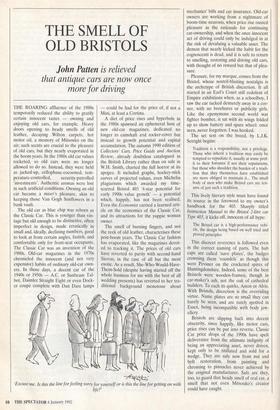THE SMELL OF OLD BRISTOLS
John Patten is relieved that antique cars are now once more for driving
THE ROARING affluence of the 1980s temporarily reduced the ability to gratify certain innocent tastes — owning and enjoying old cars, for example. Heavy doors opening to heady smells of old leather, decaying Wilton carpets, hot motor oil, a memory of Mitsouko on the air; such scents are crucial to the pleasure of old cars, but they nearly evaporated in the boom years. In the 1980s old car values rocketed, so old cars were no longer allowed to do so. Instead, they were held as jacked-up, cellophane-cocooned, tem- perature-controlled, security-patrolled 'investments'. Authentic aromas were lost in such artificial conditions. Owning an old cdr became a miser's pleasure, akin to keeping those Van Gogh Sunflowers in a bank vault.
The old car as blue chip was reborn as the Classic Car. This is younger than vin- tage but old enough to be distinctive, often imperfect in design, made erratically in small and, ideally, declining numbers, good to look at from certain angles, fastish, and comfortable only for front-seat occupants. The Classic Car was an invention of the 1980s. Old-car magazines in the 1970s chronicled the innocent (and not very expensive) habits of ordinary old-car own- ers. In those days, a decent car of the 1940s or 1950s — A.C. or Sunbeam Tal- bot, Daimler Straight Eight or even Dock- er coupe complete with Dan Dare lamps — could be had for the price of, if not a Mini, at least a Cortina.
A diet of price rises and hyperbole in the 1980s spawned an ephemeral host of new old-car magazines, dedicated no longer to camshaft and rocker-cover but instead to growth potential and capital accumulation. The autumn 1990 edition of Collectors' Cars, Price Guide and Auction Review, already doubtless catalogued in the British Library rather than on sale in W.H. Smith, charted the full horror at its apogee. It included graphs, hockey-stick curves of projected values, even Michelin plagiarisms which awarded my time- scarred Bristol 403 '4-star potential for early 1990s value growth' — a potential which, happily, has not been realised. Even the Economist carried a learned arti- cle on the economics of the Classic Car, and its attractions for the yuppie woman owner.
The smell of burning fingers, and not the reek of old leather, characterises these post-boom years. The Classic Car fashion has evaporated, like the magazines devot- ed to tracking it. The prices of old cars have reverted to parity with second-hand Sierras, in the case of all but the most exotic. As a result, She-Who-Would-Have- Them-Sold (despite having started off the whole business for me with the best of all wedding presents) has reverted to her tra- ditional background monotone about 'Excuse me. Is this the line for feeling sorry for yourself or is this the line for getting on with life?' mechanics' bills and car insurance. Old-car owners are working from a nightmare of boom-time neurosis, when price rise ousted pleasure as the rationale for continuing car-ownership, and when the once innocent act of driving could only be indulged in at the risk of devaluing a valuable asset. The demon that nearly kicked the habit for the cognoscenti is dead, and it is safe to return to smelling, restoring and driving old cars, with thought of no reward but that of plea- sure.
Pleasure, for my marque, comes from the Bristol, whose nostril-blasting nostalgia is the archetype of British discretion. It all started in an Earl's Court still redolent of Empire exhibitions when, as a schoolboy, I saw the car tucked demurely away in a cor- ner, with no brochures or publicity girls. Like the eponymous second world war fighter bomber, it sat with its wings folded up to show battery and spare wheel: once seen, never forgotten. I was hooked.
The set text on the breed, by L.J.K. Setright begins:
Tradition is a responsibility, not a privilege. Those who inherit a tradition may easily be tempted to repudiate it, usually at some prof- it to their fortunes if not their reputations, but those who shoulder the burden of a tradi- tion that they themselves have established are more obliged to maintain it... The small body of men who make Bristol cars are ten- ants of just such a tradition.
This lively literary style must have found its source in the foreword to my owner's handbook for the 403. Sharply titled Instruction Manual to the Bristol 2-litre car Type 403, it kicks off, innocent of all hype:
The Bristol car is a high-performance vehi- cle, the design being based on well tried and proved principles.
This discreet reverence is followed even in the correct naming of parts. The hub caps are called 'nave plates', the badges crowning them 'roundels' as though this were Pevsner on the crocketed spires of Huntingdonshire. Indeed, some of the best Bristols were wooden-framed, though in car-maker's ash, not the oak of cathedral builders. To each its quirks, Aston or Alvis. With Bristols, discretion is the overriding virtue. Name plates are so small they can barely be seen, and are rarely spotted in Essex, being incompatible with body jew- ellery.
Bristols are slipping back into decent obscurity, since happily, like motor cars, price rises can be put into reverse. Classic Car price drops of the 1990s have spelt deliverance from the ultimate indignity of being an appreciating asset, never driven, kept only to be titillated and sold for a wedge. They are safe now from nut and bolt restoration, from painting and chroming to pinnacles never achieved by the original manufacturer. Safe are they, too, to guard that heady smell of real car, a smell that not even Mitsouko's creator could have caught.










































 Previous page
Previous page